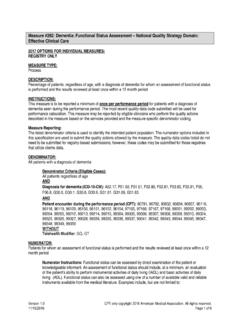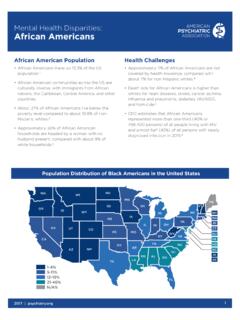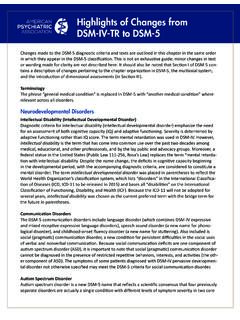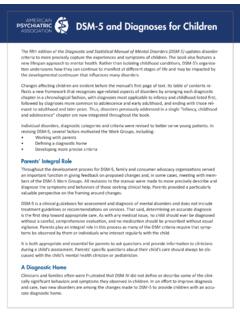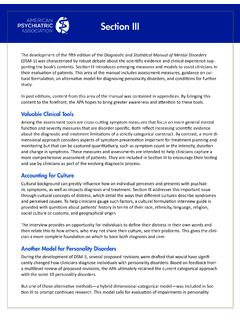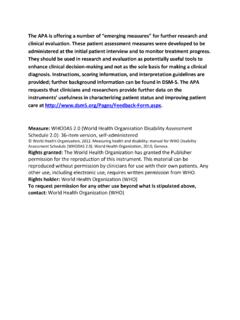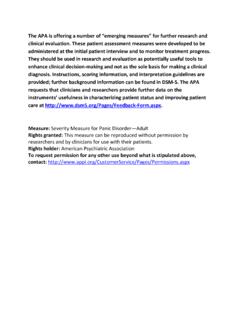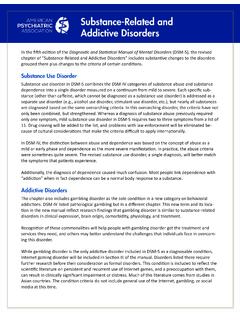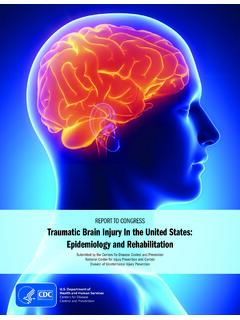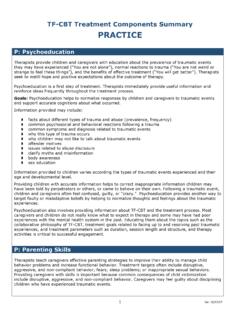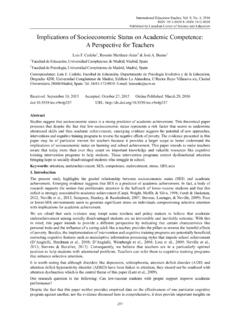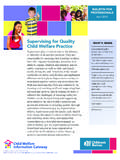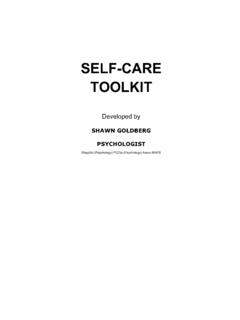Transcription of Treating Women Who Have Experienced Intimate Partner …
1 AMERICAN PSYCHIATRIC ASSOCIATION | DIVISION OF DIVERSITY AND HEALTH EQUITY | 2019 Treating Women Who Have Experienced Intimate Partner Violence Intimate Partner violence (IPV) is one of the most common form of violence against Women . It could be physical, sexual, and emotional abuse and controlling behaviors by an Intimate Partner and occurs in all settings and among all socioeconomic, cultural and religious groups. IPV may lead Women to negative health consequences, including mental health disorders. Therefore, it is important to implement IPV screening and counselling safely and effectively throughout the health care delivery system. It can be achieved by educating health care professionals in IPV screening and counseling techniques. The following sections discuss screening, safety assessment, treatment options and best practices in Treating Women who have Experienced IPV.
2 Screening for IPV Survivors in Mental Health Settings Women with mental health symptoms or disorders (depression, anxiety, post- traumatic stress disorders (PTSD), self-harm/suicide attempts) should be screened for IPV in health care settings as part of best clinical practice. Survivors should be evaluated for safety and homicide risk and undergo a general health screening. Other areas to assess include history of substance abuse/misuse and social support. In 2007, the Centers for Disease Control and Prevention released the screening tool Intimate Partner Violence and Sexual Violence Victimization Assessment Instruments for Use in Healthcare Settings: Version 1, that is widely used by providers. Safety Assessment A vital role for health care providers is to assess the safety of a survivor and develop a plan to ensure immediate safety of the survivor.
3 Health care providers may connect survivors to a nurse, social worker, advocate, community resource, or health care workers who are trained in violent prevention. Suicide Assessment Studies have found a link between the number of previous traumatic events and the risk of attempting suicide. Mental health providers should conduct a suicide risk assessment in all interactions with IPV survivors. Mental health care providers should: o Conduct the assessment in a private, confidential space. o Provide interpreters as needed. o Discuss the reasons for assessment with your patients. It will reduce their fear, anxiety and the risk of aggression. AMERICAN PSYCHIATRIC ASSOCIATION | DIVISION OF DIVERSITY AND HEALTH EQUITY | 2019 2 o Describe with as much detail as possible what is happening or going to happen which will increase a sense of control and decrease fear and anxiety.
4 O De-brief with staff involved in the process. o Work with the patient on a safety plan. This will increase a sense of control and collaboration. o Focus on coping strategies for risky situations. It will help survivors identity and reinforce strengths, social supports and motivations to seek help. Available safety planning resources can be found at Danger Assessment Every year 1,500-1,600 Women in the US are killed by their Intimate partners. About 1 in 5 Women killed or severely injured by an Intimate Partner had no previous warning; the fatal or life-threatening incident was the first physical violence they had Experienced from their Partner . The following tools are used to help determine this risk. The Danger Assessment is a widely validated tool that determines the level of danger an abused woman has of being killed by an Intimate Partner .
5 O It consists of two sections: a calendar and a 20-item scoring instrument. The calendar records the severity and frequency of IPV during the past year. o The 20-item instrument uses a weighted system to score yes or no responses to risk factors associated with Intimate Partner homicide. o The tool is available in English, Spanish, Portuguese and French. Training and certification are available in many forms including an online version. o It is also available in the form of a smartphone application for users who want to learn about the level of risk in their current relationships. The Danger Assessment-Revised (DA-R) is a tool that was also found to predict re-assault in abusive female same-sex relationships. This tool is also available, and it predicts only re-assault, not lethality. The Lethality Screen for First Responders is an assessment tool that was developed using the Danger Assessment as a guide.
6 The instrument is currently being used by law enforcement in Maryland. Training options for the Danger Assessment are available at: Treatment Psychotherapies Psychotherapies may be used to address the multiple stressors of IPV survivors, including the immediate need for safety and resources, loss of an Intimate relationship, social isolation, and parenting issues. AMERICAN PSYCHIATRIC ASSOCIATION | DIVISION OF DIVERSITY AND HEALTH EQUITY | 2019 3 The following psychotherapies that have demonstrated effectiveness in large randomized controlled trials for PTSD. Cognitive Behavioral Therapy (CBT) Present-focused non-exposure Cognitive Behavioral Therapy (CBT) helps people attain safety while helping to reduce trauma/PTSD symptoms and substance misuse. It can be delivered in the group and individual formats, in both adults and adolescents.
7 Seeking Safety, an evidence-based, integrative treatment approach is often used to help IPV survivors attain safety from trauma and PTSD. The key principles of Seeking Safety are: 1. Safety as the overarching goal (helping patients attain safety in their relationships, thinking, behavior, and emotions) 2. Integrated treatment (focus on both trauma and substance abuse) 3. A focus on ideals to counteract the loss of ideals in both trauma and substance abuse 4. Four content areas: cognitive, behavioral, interpersonal, case management 5. Attention to clinician processes (clinicians' emotional responses, self-care, etc.) STAIR (Skills Training in Affective and Interpersonal Regulation) STAIR is an evidence-based skills-focused CBT for PTSD treatment. STAIR was initially developed for individuals with PTSD related to childhood abuse (though not formally tested in IPV survivors).
8 It can be implemented in both individual and group modalities. While this psychotherapy can be complemented with an exposure component, it is primarily focused on reframing cognitions that have emerged as a result of a traumatic experience. STAIR focus on: 1. Psychoeducation about the impact of trauma on emotions and relationships 2. Emotion regulation skills 3. Effective expression of negative emotions 4. Interpersonal skills related to appropriate assertiveness 5. Development of flexibility in regard to interpersonal expectations, actions and reactions. Treatment also includes recognition of achievements during treatment and exercises in self-compassion. Interpersonal Psychotherapy (IPT) IPT has been shown to be an effective non-exposure-based treatment for PTSD. Many PTSD symptoms reflect interpersonal difficulties such as emotional withdrawal from relationships and individuals, sometimes resulting in interpersonal hypervigilance.
9 IPT directly addresses these areas by focusing on four interpersonal areas: 1. Grief, role disputes (disagreements with significant others) 2. Role transitions (changes in life circumstances) AMERICAN PSYCHIATRIC ASSOCIATION | DIVISION OF DIVERSITY AND HEALTH EQUITY | 2019 4 3. Interpersonal deficits (persistent loneliness) 4. Social supports to improve well-being Cognitive Processing Therapy (CPT) CPT is an effective treatment for reducing PTSD and depression symptoms following interpersonal victimization, including physical and sexual assault. CPT focuses on: 1. Education of PTSD symptoms 2. Effect of traumatic events 3. Connections between trauma-related thoughts, feelings, and behaviors 4. Remembering the traumatic event and experiencing the emotions associated with it 5. Ability to challenge maladaptive thoughts about the trauma 6.
10 Reduction of negative thinking patterns and motivation to learn new, healthier ways of thinking 7. Exploration of how core themes have been impacted by trauma. Eye movement desensitization reprocessing (EMDR) The EMDR integrates techniques from cognitive behavioral, psychodynamic, and body-oriented therapy. Processes identified in EMDR include mindfulness, somatic awareness, free association, cognitive restructuring, and conditioning. These processes may interact to create the positive effects achieved with EMDR. The therapy is conducted without detailed descriptions of traumatic events. HOPE (Helping to Overcome PTSD through Empowerment) It is a short-term non-exposure CBT specifically developed for battered Women with PTSD living in domestic violence shelters. The therapy focuses on stabilization, safety, and empowerment. HOPE focuses on the following : Immediate physical and emotional risks PTSD symptoms, behaviors, and cognitions that interfere with achieving shelter and treatment goals PTSD symptoms and behavioral and cognitive patterns that interfere with quality of life Post-shelter goals and safety.


